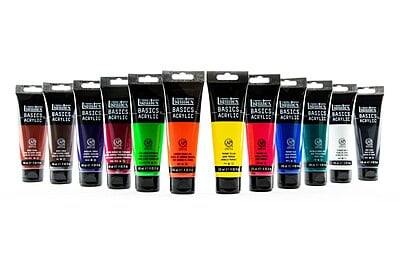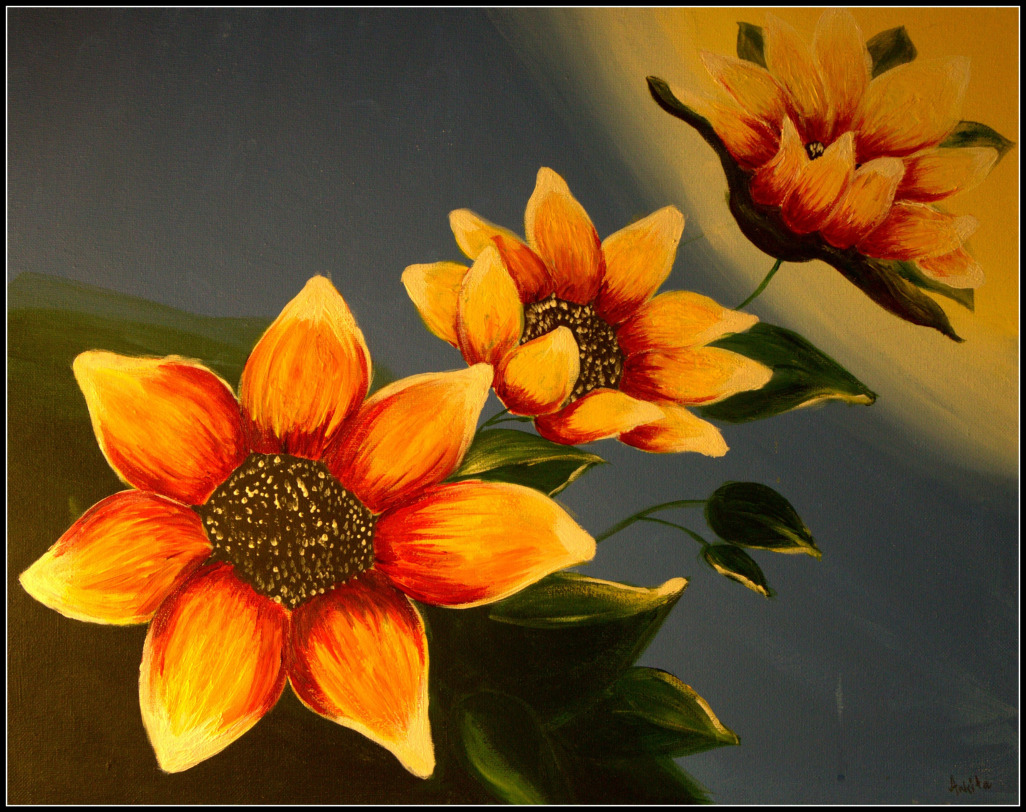Acrylic Paint™
What is Acrylic Paint?
Acrylic paint is a versatile, fast-drying medium made of pigment particles suspended in an acrylic polymer emulsion. Since its development in the mid-20th century, acrylic paint has revolutionized the art world, offering artists a flexible and durable alternative to traditional oil and watercolor paints. One of its standout features is adaptability—acrylics can be used straight from the tube for bold, textured brushstrokes or thinned with water or mediums to create delicate, transparent layers similar to watercolor effects.
Whether you're a beginner or a seasoned artist, acrylic paint is a favorite for its quick drying time, vibrant color payoff, and ability to adhere to various surfaces, including canvas, wood, paper, fabric, and even glass. From fine art to craft projects, murals to mixed media, the possibilities with acrylics are nearly endless.
Why Choose Acrylic Paint?
- Benefits of Acrylic Paint
Acrylic paint is a favorite among artists and crafters for good reason—it offers a range of practical and creative benefits that set it apart from other mediums. Whether you're working on a fine art masterpiece or a DIY home project, here’s why acrylics are an excellent choice:
- Fast Drying Time
One of the most appealing qualities of acrylic paint is its quick drying time. Unlike oil paints, which can take days or even weeks to dry, acrylics dry within minutes to hours. This allows for faster layering, quicker project completion, and fewer delays in your creative process.
- Vibrant, Long-Lasting Colors
Acrylic paint is known for its rich pigmentation and brilliant color payoff. The colors stay vivid and bold even after drying, making it ideal for expressive artworks, bold abstracts, and detailed illustrations.
- Incredible Versatility
Acrylics can be used on a wide variety of surfaces, including canvas, paper, wood, fabric, glass, ceramic, and metal. Whether you’re painting a mural, customizing clothes, or decorating furniture, acrylic paint adapts to your creative vision.
- Water-Soluble and Easy to Clean
When wet, acrylic paint is water-soluble, making it easy to clean brushes, palettes, and workspaces using just soap and water. There’s no need for toxic solvents, making it safer for home use, classrooms, and artists of all ages.
- Durable and Weather-Resistant
Once fully dry, acrylic paint forms a flexible, water-resistant layer that stands up to time and the elements. This makes it ideal for both indoor and outdoor applications, including signs, garden art, and murals exposed to varying weather conditions.

Types of Acrylic Paint™
Acrylic paint is one of the most versatile and accessible mediums in the art world, and part of what makes it so adaptable is the variety of forms it comes in. Whether you're a beginner, a professional, or a mixed media artist, understanding the different types of acrylic paint set will help you choose the best one for your technique, surface, and desired effect.
1. Heavy Body Acrylics
Consistency: Thick, dense, and buttery
Finish: Usually satin or semi-gloss
Drying Time: Fast, but a bit longer than fluid types
Ideal For:
- Impasto (thick, textured application)
- Bold brush strokes
- Palette knife painting
- Layer building and sculptural effects
Benefits:
Heavy body acrylics retain the texture and stroke of the brush or knife, making them perfect for artists who want a tactile, expressive surface, similar to working with oil paints. Their thicker nature allows you to work on vertical surfaces without dripping.
Example Use Case:
Creating a landscape with rich textures—where you want to feel the bark of trees or ripples in the water—heavy body paints are the way to go.
2. Soft Body Acrylics
Consistency: Smoother and more fluid than heavy body
Finish: Matte to satin
Drying Time: Fast, dries thinner and flatter
Ideal For:
- Glazing and blending
- Fine detail work
- Smooth layering
- Illustrative styles
Benefits:
Soft body acrylics are versatile and easy to control, making them perfect for beginners or artists working with detail. They're excellent for techniques like dry brushing, shading, and thin-layer work without losing vibrancy.
Example Use Case:
Painting portraits or still life, where precision and subtle gradations are important.
3. Fluid Acrylics
Consistency: Liquid-like, similar to heavy cream
Finish: Usually glossy
Drying Time: Very fast
Ideal For:
- Acrylic pouring
- Staining and washes
- Airbrushing
- Drip techniques and line work
Benefits:
Despite being thin, fluid acrylics are intensely pigmented. They’re perfect for artists who love the ease of motion and want smooth coverage without brush texture.
Example Use Case:
Abstract pieces with flowing color, marbling effects, or calligraphic strokes.
4. Acrylic Ink
Consistency: Ultra-fluid, like water-based ink
Finish: High-gloss and vibrant
Drying Time: Very fast
Ideal For:
- Line drawing
- Mixed media
- Watercolor effects
- Fine writing or graphic work
Benefits:
Acrylic ink offers the highest pigmentation in the thinnest form. It's perfect for pen nibs, brushes, droppers, and airbrushes. Ideal for adding bold outlines, text, or luminous details over acrylic layers.
Example Use Case:
Combining fine line work over a fluid acrylic background in a mixed media journal or illustration.
5. Interactive or Open Acrylics
Consistency: Varies—usually soft body
Finish: Matte to satin
Drying Time: Slow (up to several hours)
Ideal For:
- Extended blending
- Wet-on-wet techniques
- Artists transitioning from oil painting
- Color mixing directly on canvas
Benefits:
Open acrylics allow much more time to manipulate the paint, making them ideal for traditional painting techniques like scumbling and feathering. You can work on large areas without worrying about the paint drying too fast.
Example Use Case:
Painting a dramatic sky or portrait where blending tones seamlessly is essential.
Pro Tip: Mix and Match Types
You don’t have to stick to just one kind of acrylic. Many artists use heavy body paints for texture, soft body for layering, and inks for detail—all in the same piece. Just remember to plan your layering so that thicker types go on top of thinner ones to avoid cracking.



Essential Acrylic Painting Techniques
Acrylic paint is loved not just for its vibrant color and fast drying time, but also for the versatility it offers in technique. Whether you’re aiming for textured depth, smooth gradients, or experimental abstracts, mastering these techniques can transform your creative expression.
1. Dry Brush Technique
Effect: Rough, scratchy texture with visible brush strokes
How It Works: Use a minimal amount of paint on a dry brush and apply it over a dry surface. The result is a broken, uneven application that leaves gaps and emphasizes texture underneath.
Best For:
- Adding highlights or weathered effects
- Detailing grass, fur, or textured surfaces
- Creating movement in landscapes and abstract pieces
Pro Tip: Use stiff brushes and apply with quick, light strokes to avoid over-blending.
2. Blending
Effect: Smooth color transitions, soft gradients
How It Works: Because acrylics dry fast, blending must be done quickly. Use a slightly damp brush and work in small areas at a time. Adding a retarder or slow-drying medium helps extend working time.
Best For:
- Skies, skin tones, or soft shadows
- Smooth background washes
- Realistic transitions in portrait or nature painting
Pro Tip: Try blending two colors on the canvas directly, then soften the seam with a clean, damp brush.
3. Glazing
Effect: Transparent layers that build depth and luminosity
How It Works: Mix a small amount of acrylic paint with a glazing medium to create a transparent wash. Layer these glazes once each is dry to build richness and create visual dimension.
Best For:
- Creating glowing skin tones
- Adding light, shadow, and mood
- Enhancing color vibrancy without repainting
Pro Tip: Use soft brushes and let each layer dry completely before adding another to avoid muddying the colors.
4. Impasto
Effect: Thick, bold texture with a three-dimensional look
How It Works: Apply acrylic paint thickly using a palette knife or stiff brush. You can also mix paint with modeling paste or heavy gel medium for extra volume.
Best For:
- Dramatic expressionist work
- Textural landscapes and abstracts
- Emphasizing movement and energy
Pro Tip: Don’t be afraid to leave visible strokes or ridges—impasto celebrates raw texture and bold gesture.
5. Acrylic Pouring
Effect: Fluid, marble-like, and abstract compositions
How It Works: Mix acrylic paint with a pouring medium to achieve a smooth, flowing consistency. Pour directly onto the canvas and tilt or swipe to create organic, unpredictable patterns.
Best For:
- Abstract and intuitive art
- Decorative pieces or wall art
- Color experimentation
Pro Tip: Use a torch or heat gun to pop air bubbles and create beautiful “cells” (organic color shapes).
Bonus: Combine Techniques for Unique Results
Don’t feel limited to using just one technique per piece. Blending followed by glazing, or a textured impasto background with dry brush details, can create powerful and unique compositions.
How to Care for Your Acrylic Paint™
- Seal Your Painting with Varnish
Acrylic paint dries to a flexible, durable surface—but it’s still vulnerable to dust, pollution, UV light, and handling. Applying a final varnish gives your painting a protective layer that:
- Shields against dust and dirt
- Guards against fading from sunlight
- Enhances the vibrancy and color depth of your painting
- Creates a uniform finish (matte, satin, or glossy)
How to do it:
Let your painting dry completely—this may take up to a week for thicker applications. Choose a removable varnish formulated for acrylics and apply it with a clean brush or as a spray in a well-ventilated space. Two thin coats are typically ideal.
- Store Your Artwork the Right Way
Proper storage is essential, especially if you’re not framing or displaying your work immediately.
Do:
- Keep paintings in a cool, dry, and dark area.
- Place them upright or store them flat with support to prevent warping.
- Use acid-free tissue or glassine paper between artworks if stacking.
Don’t:
Store in damp basements or hot attics.
Stack painted surfaces against each other—this causes abrasion or sticking.
Leave paintings exposed to direct sunlight for extended periods.
Pro Tip: If you're transporting artwork, wrap it securely and cushion all sides to prevent impact damage.
- Use High-Quality Materials from the Start
Archival-quality materials make a huge difference in how your art ages.
- Canvas or board: Opt for primed, acid-free surfaces to prevent discoloration and cracking.
- Paints: Artist-grade acrylics contain higher pigment concentration and better lightfastness than student-grade paints.
- Brushes: Well-maintained brushes allow more precision and prevent bristle shedding in your painting.
Bonus Tip: Always check the lightfast rating of your paints—it tells you how resistant the pigment is to fading over time.
Final Thoughts: Why Acrylic Paint Is the Artist’s Best Friend
Acrylic painting isn’t just a medium—it’s a movement of color, creativity, and limitless experimentation.
Whether you’re a seasoned artist or a curious beginner, acrylics offer something for everyone:
- Expressive freedom with a huge range of techniques—from thick impasto to delicate glazes
- Convenience with fast drying times and easy cleanup
- Adaptability for any style, surface, or vision—from street art and fine art to fashion and home décor
- Longevity with strong adhesion, weather resistance, and vibrant color retention
And best of all? Acrylics empower you to take creative risks—to play, to learn, and to grow as an artist.
Your Artistic Journey Starts Here
So go ahead—embrace the boldness of acrylics. Mix colors fearlessly. Layer textures wildly. Capture emotions vividly. And when your piece is complete, treat it with the care it deserves.
With the right techniques and thoughtful preservation, your artwork will not only reflect your talent, it will also stand the test of time.
Benefits of Using Acrylic Paint
1. Fast Drying
Acrylic paint™ dries quickly, allowing artists to build layers and make corrections with ease. This speed is perfect for those who enjoy working in multiple sessions or like to experiment freely without long waiting times between coats.
2. Water-Based
While wet, acrylic paint can be thinned and cleaned up with water, making it beginner-friendly and safer than solvent-based mediums. Once dry, however, it becomes water-resistant, giving your artwork durability and protection.
3. Vibrant Colors
Acrylics are known for their intense pigmentation and rich color payoff. These bold hues remain bright and vivid over time, especially when artist-grade paints and UV-protective varnishes are used.
4. Versatile Application
Acrylic paint adheres well to a wide range of surfaces, including canvas, paper, wood, fabric, glass, plastic, metal, and more. This makes it a favorite for mixed media artists, muralists, and DIY enthusiasts alike.
5. Long-Lasting
When used with proper techniques, such as priming surfaces and sealing finished work, acrylic paintings are resistant to cracking, flaking, and fading. This longevity makes them suitable for both indoor and outdoor projects.
Acrylic paint not only offers creative freedom but also adapts to an artist's evolving style. Whether you're experimenting with fluid pouring techniques, creating textured impasto pieces, or blending smooth, realistic portraits, acrylics respond beautifully to every approach. With the wide range of media available—such as gels, pastes, retarders, and varnishes—you can further manipulate the paint’s behavior to suit your vision. This flexibility is what makes acrylic paint so appealing across different art forms, from contemporary abstract to mixed media and fine art illustration.
Beyond its technical strengths, acrylic painting fosters a mindset of exploration and play. Artists can embrace spontaneity, layering, and even happy accidents without the long drying times or toxic cleanup associated with other mediums. It's also incredibly beginner-friendly, making it a favorite in schools, studios, and workshops around the world. Whether you're painting for personal expression, therapeutic relaxation, or professional presentation, acrylic paint provides the perfect balance of control and creativity to bring your ideas to life in a lasting and impactful way.
In essence, acrylic painting is far more than just a medium—it's a powerful gateway to artistic discovery and expression. With its fast-drying nature, intense pigmentation, and remarkable versatility, acrylic paint offers a unique combination of freedom and control that appeals to beginners and professional artists alike. It adapts easily to any style, whether you're into bold, textured abstracts or soft, realistic portraits. As you experiment with different techniques—like glazing, pouring, impasto, or dry brushing—you'll uncover new ways to bring your vision to life.
Acrylics also evolve with your creativity. Whether you're painting on canvas, wood, metal, or fabric, they deliver vibrant, long-lasting results that truly stand out. And because they're durable and resistant to fading or cracking when properly used, your artwork can remain beautiful and intact for years to come. As your skills grow and your artistic journey unfolds, acrylic painting offers endless possibilities to explore, refine, and showcase your unique voice. Each brushstroke becomes more than a mark on a surface—it becomes part of a story, a statement, and a lasting impression that transcends time.
Final Thoughts on Acrylic Paint™
Acrylic paint is a dynamic and versatile medium that offers something for every artist, whether you're a beginner exploring your creativity or a professional perfecting your technique. Its fast-drying nature, vibrant colors, and adaptability across surfaces make it an ideal choice for everything from fine art to DIY crafts and large-scale murals.
Thanks to its durability and ease of use, acrylic painting continues to grow in popularity across creative fields. By mastering different consistencies, tools, and techniques, you can unlock endless possibilities and bring your artistic vision to life. With a little practice and the right materials, acrylics will become a powerful and reliable tool in your artistic journey.
So grab your brushes, pick your palette, and let your imagination flow—because with acrylic paint, there are no limits to what you can create!